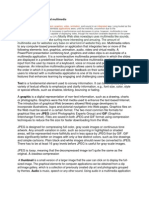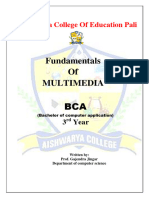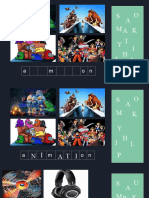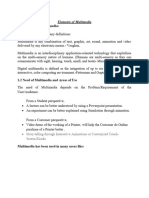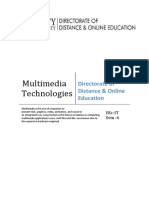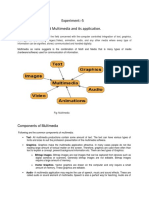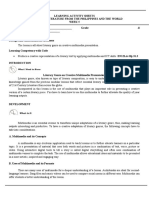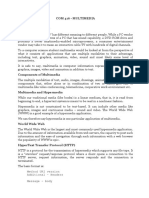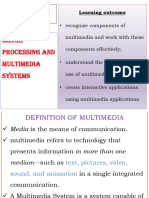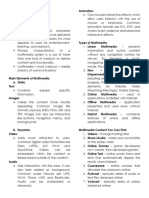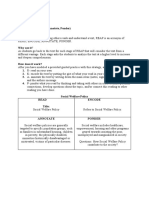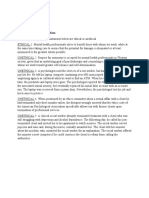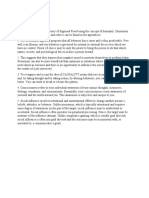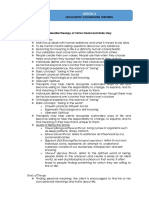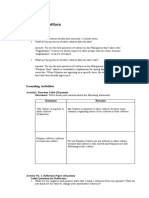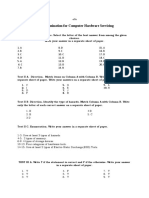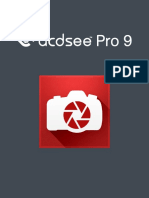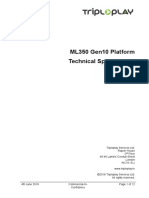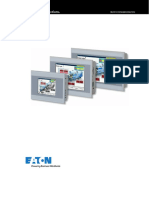Collaborative ICT Development
Interactive Multimedia
• Rich content in the online environment
• Multimedia and interactivity
Multimedia Contents
1. Videos. Through video hosting sites, you can take a video and show it to the entire world (e.g., YouTube).
2. Sound, Music, or Audio. If videos are too much for you, you can always record sounds. You can now share your sound bites to the entire
world (e.g., Soundcloud).
3. Online games. Game developers now create what is called “browser-based games.” You do not need to install these games to your computer
as they run in most updated web browsers (Adventure Quest, Farmville, Candy Crush)
4. Online tests. Online survey forms and tests that automatically display the results when finished (Online IQ and Personality Tests).
5. Courseware. Online courses that simulate the classroom online (e.g., E-learning Courses using a Learning Management System)
.
6. Podcasts. An episodic series of audio or text files streamed online (e.g., Stuff You Should Know, TED Talks, The Starters, Ear Biscuits).
7. Vodcasts. An episodic series of video streamed online (e.g., YouTube series/shows like Video Game High School, Good Mythical Morning).
Inserting YouTube Videos on Your Blog Post
Search this song on YouTube.com (you can use an official music video or someone else’s.
Go to the bottom of the video and click the Share button.
Click on Embed.
Copy the code similar to the screenshot below.
Create a new post on your WordPress then on the editor, click on the Text tab.
Paste your code.
Go back to the Visual tab and add text content on either the top of your video or the bottom.
Preview then publish the content.
Uses of Multimedia:
1.Education – Multimedia is use to create and produce computer-based training (CBT) materials and courses, including online and CD based
encyclopedias. It has been observed that learning is faster and easier with a properly assembled multimedia of voice, video, graphics and texts.
• EDUTAINMENT (Education and Entertainment) is a term pertains to the combination of education and entertainment which also finds
acceptance to children of today who are exposes to games and entertainment.
2. Entertainment – multimedia use is very much in any modern movies and animations to develop special effects and virtual world.
• Computer games also use multimedia content and features to make them more exciting and relevant.
• Interactive media is a term applied to multimedia applications that allow users to take part, contribute and participate in online games.
3. Business – PowerPoint presentation that uses all kinds of media; are able to effectively convey information to clients, superiors, co-
workers, owners, and the general public.
4. Medicine – multimedia is very important in medicine to train future doctors and practitioners, for example, in micro and virtual surgery,
multimedia can also simulate the effects of viruses and disease to human body to clearly find and develops ways of preventing them.
5. Mathematics and Scientific Research – multimedia issued to simulate and model various situations that would otherwise be difficult to
grasp in real time, as in the case of an erupting volcano or tornado, wherein after effects can be presented to colleagues or to the learning
public.
• Mathematical equations and formulas that can be represented as visual models can easily be viewed by the use of multimedia.
• Chemical and molecular models can be also using multimedia to present, manipulate and create new substances.
�6. Government – multimedia is used by governments around the world to convey information, procedure and regulations for their citizen
and visitors. Multimedia also finds uses in military, engineering and many other fields, and also, propaganda.
7. Multimedia and interactivity – multimedia applications can include various types of media used together (for example: text, images,
video, audio, animation, etc.) the primary characteristic of a multimedia system is the use of more than one kind of media to deliver content and
functionality. A multimedia application normally involves programming code and enhances user interaction where the computer responds to the
user’s actions.
Types of Rich and Multimedia Content:
1. Text ¬– is an important component used in many multimedia applications. They are characters that are used to create words, sentences,
and paragraphs. Text alone provide just once source of information. Yet, text is good at providing basic information.
2. Images – make the content more visually appealing. Common image file formats used are JPEG, PNG, GIF, and TIFF. Image can also be
interactive like buttons, navigational menus, and backgrounds.
• JPEG (acronym for the Joint Photographic Experts Group) which created the standard in 1992. The basis for JPEG is the discrete cosine
transform (DCT), a lossy image compression technique that was first proposed by Nasir Ahmed in 1972. JPEG was largely responsible for the
proliferation of digital images and digital photos across the Internet, and later social media.
• PNG (Portable Network Graphics) – is a raster-graphics file-format that supports lossless data compression. PNG was developed as
improved, non-patented replacements for Graphics Interchange Format (GIF). PNG supports palette-based images, grayscale images, and full-
color non-palette-based RGB or RGBA images.
• GIF (Graphics Interchange Format) – is a bit-mapped graphics file format used by the World Wide Web, CompuServe and many BBSs. GIF
supports colours and various resolutions. It also includes data compression, but because it is limited to 256 colours, it is more effective for
scanned images such as illustrations rather than colour photos.
• TIFF (Tagged Image File Format) – abbreviated TIFF or TIF, is a computer file format for storing raster graphics images, popular among
graphic artists, the publishing industry and photographers.
3. Video – adds more attraction to users. Common digital video formats are Flash, MPEG, AVI, WMV, and QuickTime. Video can be
embedded within content or linked stored outside the content.
• Flash (or Adobe Flash) – is a container file format used to deliver digital video content over the Internet using Adobe Flash Player version
6 and newer. Flash video content may also be embedded within SWF files. There are two different Flash Video Formats: FLV and F4V.
• SWF is an Adobe Flash file format used for multimedia, vector graphics and ActionScript.
• MPEG (Moving Picture Experts Group) – is a working group of authorities that was formed by ISO and IEC to set standards for audio and
video compression and transmission. It was established by 1988 by the initiative of Hiroshi Yasuda and Leonardo Chiariglione, group Chair since
its inception.
• AVI (Audio Video Interleave) – is a multimedia container format introduced by Microsoft in November 1992 as a part of its Video for
Windows software (Media Player to be specific). AVI files can contain both audio and video data in a file container that allows synchronous
audio-with-video playback.
• WMV (Windows Media Video) – is a series of video codecs and their corresponding video coding formats developed by Microsoft. It is
part of the Windows Media framework.
4. Audio – aids interactions with the user. It can also be added as background. Common audio formats are MP3, WMA, Wave, MIDI and
RealAudio. Audio can be embedded or streamed.
• MP3 – is a file format commonly designates files containing an elementary stream of MPEG-1 audio and video encoded data, without
other complexities of the MP3 standard.
• WMA (Windows Media Audio) – is a series of audio codecs and their corresponding audio coding formats developed by Microsoft. It is a
proprietary technology that forms part of the Windows Media framework. WMA consists of four distinct codecs.
�• Waveform Audio File Format (WAVE or WAV) – is an audio file format standard, developed by Microsoft and IBM, for storing an audio
bitstream on PCs.
• MIDI – is a technical standard that describes a communications protocol, digital interface, and electrical connectors that connect a wide
variety of electronic musical instruments, computers, and related audio devices for playing, editing and recording music.
• RealAudio – is a proprietary audio file format developed by RealNetworks and first released in April 1995. It uses variety of audio codecs,
ranging from low-bitrate formats that can be used over dialup modems, to high-fidelity formats for music.
5. Animation – can include interactive effects which allow users interact with the use of mouse or keyboard. Common animation formats
are FLV, SWF, and ActionScript codes for animated and interactive effects.
6. Online Games – are universal in modern gaming platforms, including PC consoles and mobile devices.
7. Online texts and courseware – are design for teachers and students. Courseware can include materials for computer-based training,
interactive tutorials, distance learning or home schooling.
8. Web-, game-, pod-, and vod-casting – A podcast is an episode series of digital media files which an user can set up so that new episodes
are automatically downloaded via web syndication to the user’s own local computer or portable media player.
A webcast is a media presentation distributed over the Internet using streaming media technology to distribute a single content source to many
principles as Podcasting with the addition of video.
Digital Multimedia – is the field concerned with the computer –controlled integration of text, graphics, still and moving images, animations,
sounds, and any other medium are every type of information can be presented, stored, transmitted and process digitally.
Computer Hardware for Animation and Multimedia
Computer hardware to be used in handling animation and multimedia may require more powerful components. Both of these applications need
a lot of memory to process which means that the computer hard disk and RAM should be bigger than computers that are just used for the
Internet and word processing. A video card installed in the computer may also help when handling videos and animations.
Video Cameras:
Transferring video from the above device to your computer may vary depending on the storage media of the device, and file formats.
There are 3 common types of video cameras:
1. Professional Video Camera – is a high-end video recording device that records high quality videos. It is usually used for television.
2. Camcorder – is a portable video camera and video recorder in one that is why it is called camcorder. It is a consumer device and many
individuals own one for personal video recording. Modern camcorders employ optical discs, memory cards or hard disks as storage media.
3. Digital camera – can record video including those found in mobile phones, PDAs, web camera, DSLRs, and digital cameras.
Sources of Videos:
1. Personal and Professional Videos – are created using your home video. Even your digital camera or cellular phone with video capability
can be used as a valid source for your projects. You can also hire professionals to do it for you, using high-end equipment that delivers quality
output for a project or event. These two options ensure that you own the copyright of the work.
2. Online Video Clips – are videos available for purchase from the Internet. You can pay for the right to use these clips. Online sourcing of
video clips may be cheaper in many situations, where its contents may require you to travel and spend much more if you do so.
3. Computer-generated Pictures – are videos made with the use of computers. You can create them using programs that come with your
operating system. Such as the case of MS windows that comes with Windows Movie Maker. It is a simple program that allows you to create
videos your stored pictures and other resources within your computer.
:






